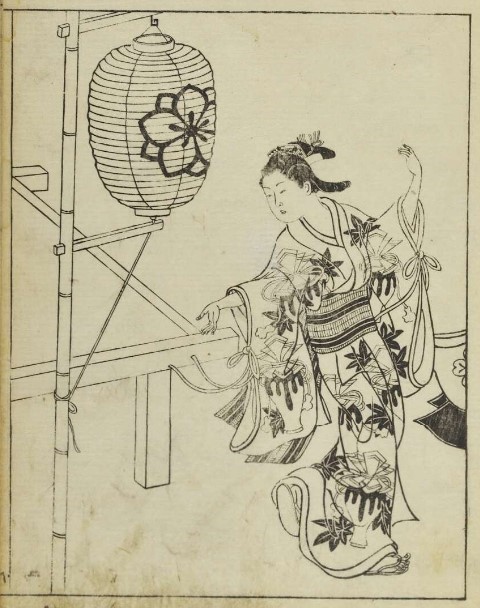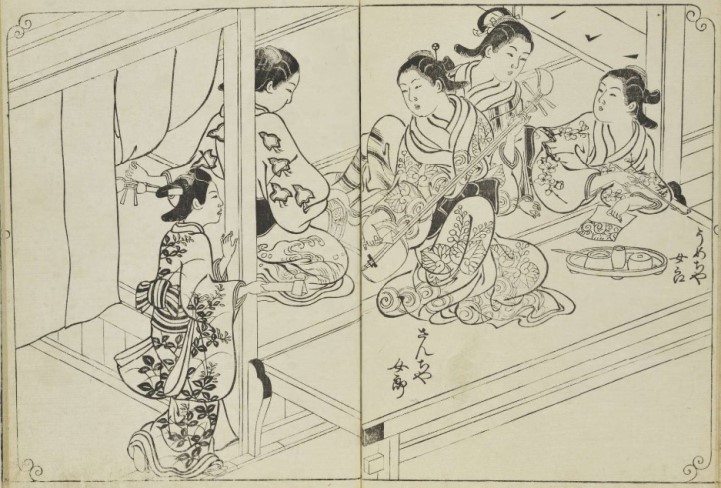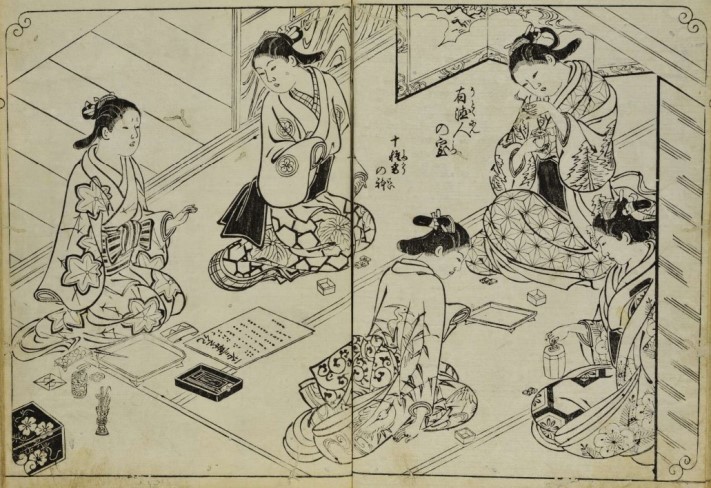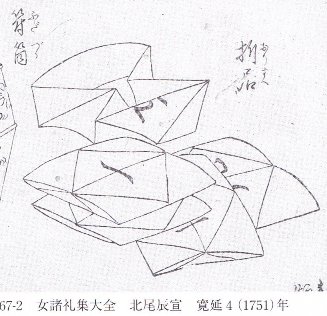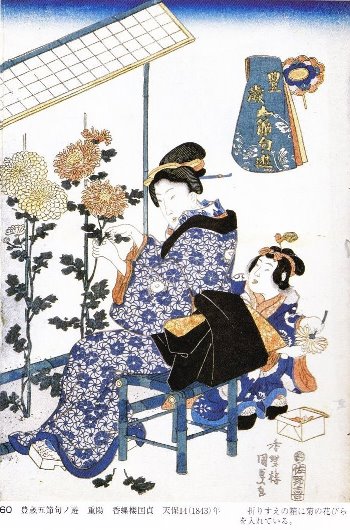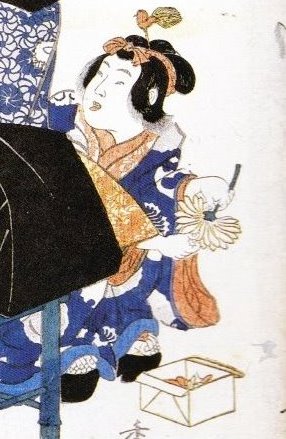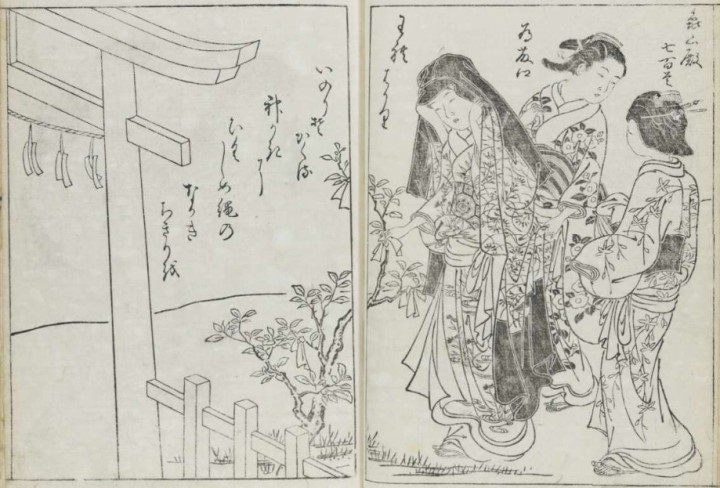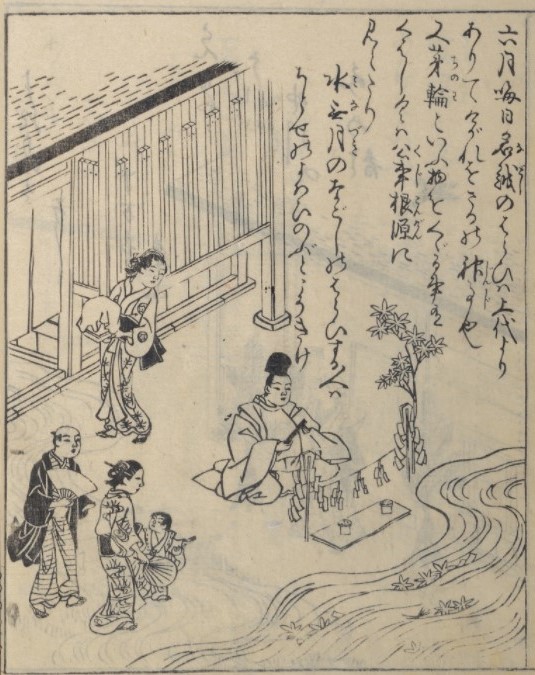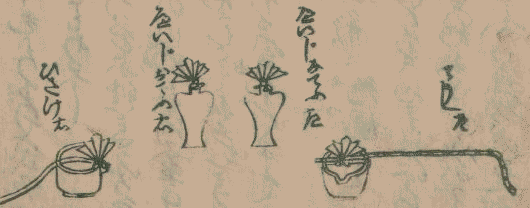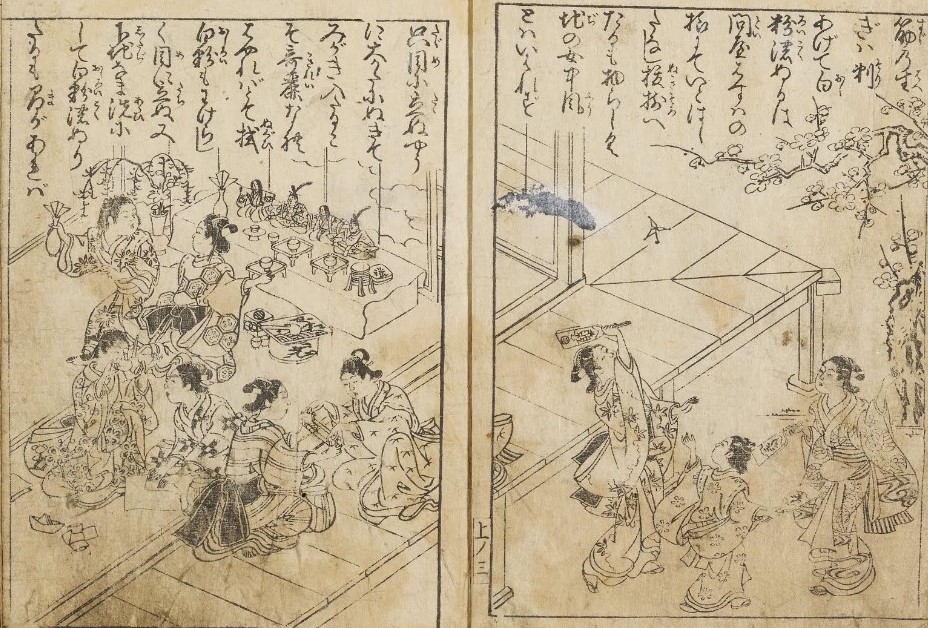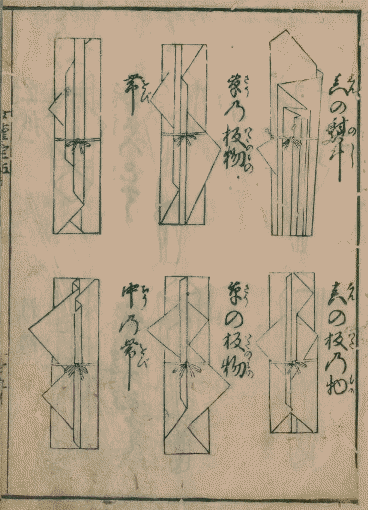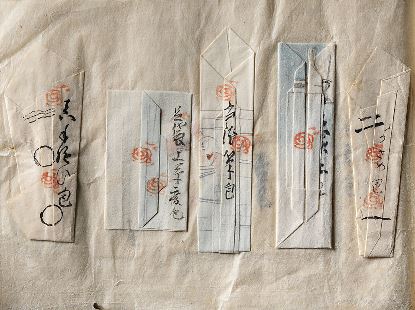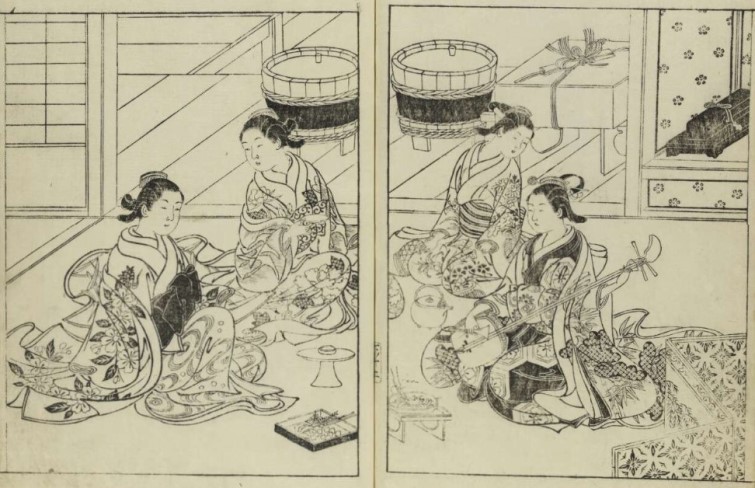| The Public Paperfolding History Project
x |
|||||||
| A Brief History of Practical, Religious, Ceremonial and Etiquettical Paperfolding in Japan | |||||||
The knowledge of how to make paper is thought to have reached Japan from China via Korea in about 610. We can reasonably conjecture that it was not long after this that paper was being folded for everyday practical purposes. However, evidence to confirm this conjecture is largely lacking. A: Practical paperfolding i. Pleated Collapsible Paper Fans The earliest kind of paperfolding we know of from Japan is the folding of kawahori or pleated paper fans. In 988, for instance, such a fan appears in a document, 'Relationship with Japan of the Song History', which lists a kawahori as being among gifts given from Japan to the Song Dynasty in China. The oldest surviving example, the remains of which were found in the village of Akitsu, was made around 1000. There is a record of a kawahori, or pleated paper folding fan, being gifted to the Chinese Song Dynasty in 988. ********** ii. Collapsible Paper Lanterns Collapsible paper lanterns sometimes appear in Edo period prints, and have remained in use until the present day. This print is by Nishikawa Sukenobu from 'Ehon tokiwa gusa', and was published in 1731. This type of lantern was probably imported from China at a much earlier date.
********** iii. Books Information about this topic will be added here in due course. ********** iv. Letterfolds In the period under consideration, letters were generally written on oblong paper, arranged landscape fashion, then folded sideways several times to reduce their width to a more manageable size. Sometimes either one, or both, of the ends of this strip were then folded backwards to prevent the letter unfolding while it was being delivered. This type of letter folding was purely practical but Japanese literature mentions, and woodcut prints sometimes show, other ways of folding, or wrapping letters which, although they may have served a practical purpose, may also have had a ceremonial or social significance. Two famous books, the 'Pillow Book of Sei Shonagon',which was completed by 1002, and the 'Genji Monogatari' (The Tale of Genji), which was completed around 1021, contain references to folded letters, which are characterised as straight folded, knotted, twisted, or wrapped. For instance, in her list of 'Depressing Things' Sei Shonagan mentions a 'twisted or knotted' letter:
Love letters in particular, it appears, were often folded into knots, but it is not clear that every knotted letter was a love letter, or that every love letter was folded into a knot. ********** In another list, of Hateful Things, Sei Shonagon also mentions the custom, apparently ubiquitous among the samurai classes, of carrying a folded wad of thin, almost tissue-like paper, known as kaishi, in the front folds of their robes, which could be used for mundane everyday purposes. It is likely that, on occasion,when no more suitable type of paper was at hand, this paper was also used for the writing of letters and poems, the folding of tsutsumi (see below), or perhaps even for the folding of paper packets or other paperfolding designs.
********** This print, in which the woman on the left is holding a knotted letter, comes from Nishikawa Sokenobu's illustrated book 'Hyakunin Joro Shinasadame' (100 Women Classified According to Their Rank), which was published in 1723.
********** v. Packets and containers A design for a folded package, which can be called the Basic Packet, occurs in many early woodcut prints,from 1648 onwards. It is distinguished by the simple way in which both short ends are folded back underneath (in a similar way to the Straight Letter). Basic Packet designs occur in various forms, either plain, or decorated with one or two protruding triangular flaps. I do not know the significance of these variations. In the print below, which is by Nishikawa Sukenobu, and comes from from Volume 1 of 'Hyakunin Joro Shinasadame', published in 1723, the Basic Packet is lying on the floor in front of the woman on the left. In this case it is a version decorated with two protruding triangular flaps.
********** Another kind of practical container, which we can call the Collapsible Box, first appears in the 'Onna Shorei Shutaizen' by Tatsunobo Kitao which was published in 1751. This design is folded from a 2x3 rectangle.
********** The same design, although with the handles folded in a different way, appears, as a box being used to hold chrysanthemum petals, in a print by Kunisada Utagawa, which can be dated to 1843.
********** B: Religious paperfolding The main religious use of paperfolding in Japan was for the construction of Shide, sacred streamers, which are symbols of purification in the Shinto religion and are often attached to a shimenawa, a rice straw or hemp rope, that marks the boundary of the sacred area of a Shinto shrine or surrounds a rock or tree etc., believed to shelter a kami (a spirit). Shide were originally made from cloth, but there is evidence that Shide made by cutting and folding paper, were in use by 1702, although the practice is probably much older than this. This print from the picture book 'Ehon chiyomigusa' by Nishikawa Sukenobu, which was published in 1741, shows a simple form of shide hanging from a shimenawa (a sacred rope) attached to a torii (the gate that forms the entrance to a shrine).
********** This print from the picture book 'Ehon Setsugekka' by Nishikawa Sukenobu, which was published in 1768, shows two gohei (a staff with two shide attached) stuck in the ground. Between them is a shimenawa from which small shide are hung.
********** C: Ceremonial paperfolding Stylised Paper Butterflies / Ocho and Mecho Stylised folded paper butterflies, were, and still are, attached to sake kettles during Shinto wedding ceremonies. Evidence for their early use can be found in the ‘Onna Chohoki’, published in 1692, but, once again, it is likely that they were in use much earlier. The butterflies in the illustrations in the 'Onna Chohoki' seem to be of a single design, but they are also found in more complex differentiated male and female forms, called Ocho and Mecho.
Detail of a page from the 'Onna Chohoki' ********** Similar folded paper butterflies were also used as decorations for sake bottles during certain Japanese festivals, such as Hinamatsu (the Doll's Festival) which is still celebrated annually on March 3rd. This print, by Nishikawa Sukenobu, from 'Onna Fuhzoku Tama kagami', which was published in 1723, shows older children celebrating Hinamatsu. The child to the upper left is holding a sake bottle decorated with a folded paper butterfly. Another sake bottle decorated in the same way sits on the table in front of the dolls.
********** D: Etiquettical paperfolding The word 'etiquettical' is an uncommon, but genuine, English word. This kind of paperfolding, sometimes called orikata, originated among samurai clans whose whole lives were lived according to a formal code of etiquette. The words 'ceremonial' and 'formal' are often used to describe this kind of paperfolding, but it seems to me that neither is quite correct and that 'etiquettical', although uncommon, should be preferred. There were several, perhaps many, schools of etiquette in the samurai period, of which the Ogasarawa school was, and remains, the most influential. Part of the formal etiquette of Samurai families was the folding of tsutsumi (or wrappers). These were of two types. Open wrappers were used to wrap / decorate the stems of flowers or greenery displayed within the home, or given as gifts, on various specific days throughout the year. Closed wrappers were packages designed to contain seeds, spices etc. In both cases the designs were specific to the items they were intended to contain. According to Ise Sadatake, writing in his book 'Hoketsuki', which was published in 1764, this type of paperfolding dates back to the Muromachi period (1333 to 1573). This may well, of course, be true, but the earliest evidence for these designs that I am currently aware of also comes from the ‘Onna Chohoki’, published in 1692.
A specimen page from the 'Onna Chohoki' ********** Actual folded examples of many of these wrappers, folded in the third month of 1697, under the instruction of a master of the Ogasawara school of etiquette, survive in an album, 'Origata Tehon of Kikuchi Fujiwara no Takehide', which is now held in the collection of the Metropolitan Museum in New York.
A specimen page from the 'Origata Tehon' ********** ii. Noshi Noshi are folded paper decorations which are used to decorate boxes, envelopes or other kinds of packaging, particularly the packaging of gifts. This print by Nishikawa Sukenobu, from Volume 3 of 'Ehon Tokiwagusa' (Picture Book of the Evergreens), which was published in 1731, shows a Noshi attached to a large box (in the upper part of the right hand panel). This may well be a common type of noshi in the form of a wrapper containing dried strips of abalone. One special kind of open wrapper, called Noshi, were originally used to enclose dried abalone (in strip form). Noshi were, and still are, commonly attached as decorations to boxes, envelopes or other packaging containing gifts, although in modern times the dried abalone strips have been replaced by simple strips of paper.
********** |
|||||||
